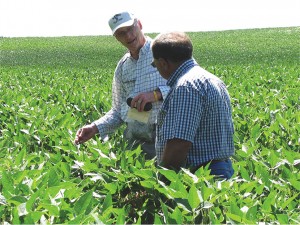Each year we seek nominations for recipients of our “Excellence in IPM” award, which recognizes exceptional IPM practitioners who do exceptional work. And when the nominations come in, we’re reminded again of the dedication and support of so many whose work truly makes a difference for the people of New York and often well beyond.
In alphabetical order, awardees of 2014:
Richard Belowski learned his craft on the job, rising through the ranks to become golf-course superintendent at Battle Island State Park in Fulton, NY. But on the way he worked at Bethpage State Park, the first public golf course to host the U.S. Open — and a longstanding home to IPM research. At Battle Island, Belowski has made the entire course available for research, graciously explaining to golfers why this matters when their favorite fairway is closed. He walks the talk, too. Case in point: staying out by moonlight to apply beneficial organisms to combat grubs.

Floriculture specialist Nora Catlin brings IPM expertise to commercial greenhouse growers on the east end of Long Island. Many are among the largest operations in New York and the Northeast, and all are in the business of growing plants that have to look pretty. But when bugs or pathogens — or even production techniques that inadvertently create inviting places for pests to call home — Catlin is there with solutions. From helping set up bench washers that rinse away bugs on orchids to identifying almost impossibly small bugs with a big impact on a range of crops, Nora’s guidance makes IPM work for these growers.

Allison Taisey’s infectious humor, powerful (but never overpowering) work ethic, deep knowledge base, and easy confidence in communicating with all sorts of audiences have made her an outstanding example of what the principles of the Excellence in IPM award reflect. Whether it’s cockroaches, mice, or bed bugs (especially bed bugs!), Taisey’s informative training sessions for both practitioners and householders have earned her a place among the leading lights in the world of the urban integrated pest management.
Field crops and livestock are Keith Waldron’s stock in trade. And whether he’s working with farmers, extension educators, or industry reps, his dependability, responsiveness, and productivity have earned him broad respect as an honest broker — and one whose caring attitude and ready humor help diffuse conflict among, say, farmers and neighboring homeowners. Meanwhile, Waldron’s hands-on teaching materials for classes held in farmers’ fields have made the principles of IPM so much easier to understand. In fact, one nominator recalls an aphid infestation found during class time — just in time to save his crop.

Mark Whitmore was the “Paul Revere” of sneaky invasive pests such as emerald ash borer and hemlock wooly adelgid long before they crossed the state line. But his warnings of the devastation they could provoke in our forests and parks have never been couched in the language of hand-wringing and despair, but rather hope and sound solutions — making Whitmore the go-to expert for groups and institutions ranging from volunteer citizen science groups to the New York State Department of Environmental Conservation.
Awards are given at meetings, conferences, and similar venues where awardees can be recognized among their peers. For these five, our deepest gratitude.